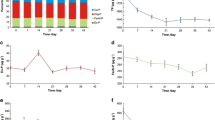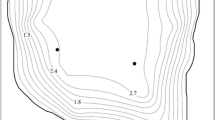Abstract
Open-cut mining operations can form pit lakes on mine closure. These new water bodies typically have low nutrient concentrations and may have acidic and metal-contaminated waters from acid mine drainage (AMD) causing low algal biomass and algal biodiversity. A preliminary study was carried out on an acidic coal pit lake, Lake Kepwari, in Western Australia to determine which factors limited algal biomass. Water quality was monitored to obtain baseline data. pH ranged between 3.7 and 4.1, and solute concentrations were slightly elevated to levels of brackish water. Concentrations of N were highly relative to natural lakes, although concentrations of FRP (<0.01 mg/L) and C (total C 0.7–3.7 and DOC 0.7–3.5 mg/L) were very low, and as a result, algal growth was also extremely low. Microcosm experiment was conducted to test the hypothesis that nutrient enrichment will be able to stimulate algal growth regardless of water quality. Microcosms of Lake Kepwari water were amended with N, P and C nutrients with and without sediment. Nutrient amendments under microcosm conditions could not show any significant phytoplankton growth but was able to promote benthic algal growth. P amendments without sediment showed a statistically higher mean algal biomass concentration than controls or microcosms amended with phosphorus but with sediment did. Results indicated that algal biomass in acidic pit lake (Lake Kepwari) may be limited primarily by low nutrient concentrations (especially phosphorus) and not by low pH or elevated metal concentrations. Furthermore, sediment processes may also reduce the nutrient availability.



Similar content being viewed by others

References
APHA (1998) Standard methods for the examination of water and wastewater, 20th edn. American Public Health Association, American Water Works Association, Water Environment Federation, Washington DC
Campbell PGC, Stokes PM (1985) Acidification and toxicity of metals to aquatic biota. Can J Fish Aquat Sci 42:2034–2049
Castro JM, Moore JN (2000) Pit lakes: their characteristics and the potential for their remediation. Environ Geol 39:1254–1260
Davis JA, Rosich RS, Bradley JS, Growns JE, Schmidt LG, Cheal F (1993) Wetland classification on the basis of water quality and invertebrate community data, vol 6. Water Authority of Western Australia and the Western Australian Department of Environmental Protection, Perth
Davison W, George DG, Edwards NJA (1995) Controlled reversal of lake acidification by treatment with phosphate fertilizer. Nature 377:504–507
Dessouki TCE, Hudson JJ, Neal BR, Bogard MJ (2005) The effects of phosphorus additions on the sedimentation of contaminants in a uranium mine pit-lake. Water Res 39:3055–3061
Fisher TSR, Lawrence GA (2006) Treatment of acid rock drainage in a meromictic mine pit lake. J Environ Engg 132:515–526
Fyson A, Nixdorf B, Kalin M, Steinberg CEW (1998) Mesocosm studies to assess acidity removal from acidic mine lakes through controlled eutrophication. Ecol Eng 10:229–245
Fyson A, Nixdorf B, Kalin M (2006) The acidic lignite pit lakes of Germany—microcosm experiments on acidity removal through controlled eutrophication. Ecol Eng 28:288–295
Hecky RE, Kilham P (1988) Nutrient limitation of phytoplankton in freshwater and marine environments: a review of recent evidence on the effects of enrichment. Limnol Oceanogr 33:796–822
IBM SPSS (2011) IBM SPSS statistics, 19th edn. IBM, New York
Kalin M, Cao Y, Smith M, Olaveson MM (2001) Development of the phytoplankton community in a pit-lake in relation to water quality changes. Water Res 35:3215–3225
Kalin M, Wheeler WN, Olavesonc MM (2006) Response of phytoplankton to ecological engineering remediation of a Canadian Shield Lake affected by acid mine drainage. Ecol Eng 28:296–310
Kamjunke N, Tittel J, Krumbeck H, Beulker C, Poerschmann J (2005) High heterotrophic bacterial production in acidic, iron-rich mining lakes. Microbial Ecol 49:425–433
Kapfer M (1998) Assessment of the colonization and primary production of microphytobenthos in the littoral of acidic mining lakes in Lusatia (Germany). Water Air Soil Poll 108:331–340
Kleeberg A (2002) Phosphorus sedimentation in seasonal anoxic Lake Scharmützel, NE Germany. Hydrobiologia 472:53–65
Kleeberg A, Grüneberg B (2005) Phosphorus mobility in sediments of acid mining lakes, Lusatia, Germany. Ecol Eng 24:89–100
Koschorreck M, Tittel J (2007) Natural alkalinity generation in neutral lakes affected by acid mine drainage. J Environ Qual 36:1163–1171
Koschorreck M, Bozau E, Frommichen R, Geller W, Herzsprung P, Wendt-Potthoff K (2007) Processes at the sediment water interface after addition of organic matter and lime to an acid mine pit lake mesocosm. Environ Sci Tech 41:1608–1614
Kumar RN, McCullough CD, Lund MA (2009) Water resources in Australian mine pit lakes. Mining Tech 118:205–211
Le Blanc Smith G (1993) Geology and Permian Coal Resources of the Collie Basin, Western Australia. Geological Survey of Western Australia. Report 38.
Lessmann D, Fyson A, Nixdorf B (2000) Phytoplankton of the extremely acidic mining lakes of Lusatia (Germany) with pH <3. Hydrobiologia 433:123–128
Lessmann D, Fyson A, Nixdorf B (2003) Experimental eutrophication of a shallow acidic mining lake and effects on the phytoplankton. Hydrobiologia 509:753–758
Lund MA, McCullough CD (2008) Limnology and ecology of low sulphate, poorly-buffered, acidic coal pit lakes in Collie, Western Australia. In: Proceedings of the 10th International Mine Water Association (IMWA) Congress, Karlovy Vary, Czech Republic, 591–594.
Lund MA, McCullough CD (2011) Restoring pit lakes: factoring in the biology. In: McCullough CD (ed) Mine pit lakes: closure and management. Australian Centre for Geomechanics, Perth, pp 83–90
Lund MA, McCullough CD, Yuden Y (2006) In-situ coal pit lake treatment of acidity when sulfate concentrations are low. In: Barnhisel RI (ed) Proceedings of the 7th International Conference on Acid Rock Drainage (ICARD). American Society of Mining and Reclamation (ASMR), St Louis, pp 1106–1121
Lyche-Solheim A, Kaste O, Donali E (2001) Can phosphate help acidified lakes to recover? Water Air Soil Poll 130:1337–1342
Martin AJ, Crusius J, McNee JJ, Whittle P, Pieters R, Pedersen TF (2003) Field-scale assessment of bioremediation strategies for two pit lakes using limnocorrals. Proc of 6th International Conference on Acid Rock Drainage, Cairns, Australia, pp. 529–539.
McCullough CD (2008) Approaches to remediation of acid mine drainage water in pit lakes. Int J Mining Reclam Env 22:105–119
McCullough CD, Lund MA (2006) Opportunities for sustainable mining pit lakes in Australia. Mine Water Environ 25:220–226
McCullough C, Van Etten EJB (2011) Ecological restoration of novel lake districts: new approaches for new landscapes. Mine Water Environ 30:312–319
McCullough CD, Lund MA, Zhao LYL (2010) Mine voids management strategy (I): pit lake resources of the Collie Basin. MiWER/Centre for ecosystem management report 2009–14. Edith Cowan University, Perth, p 250
Müller M, Eulitz K, McCullough CD, Lund MA (2011) Model-based investigations of acidity sinks and sources of a pit lake in Western Australia. In: Proceedings of the International Mine Water Association (IMWA) Congress, Aachen, Germany
Neil LL, McCullough CD, Lund MA, Tsvetnenko Y, Evans L (2009) Toxicity assessment of acid mine drainage pit lake water remediated with limestone and phosphorus. Ecotox Env Saf 72:2046–2057
Nixdorf B, Mischke U, Lesmann D (1998) Chrysophytes and chlamydomonads: pioneer colonists in extremely acidic mining lakes (pH <3) in Lusatia (Germany). Hydrobiologia 369(370):315–327
Nixdorf B, Fyson A, Krumbeck H (2001) Review: plant life in extremely acidic waters. Environ Exp Bot 46:203–211
Nixdorf B, Lessmann D, Deneke R (2005) Mining lakes in a disturbed landscape: application of the EU water framework directive and future management strategies. Ecol Eng 24:67–73
Peterson HG, Healy FP, Wagemann R (1984) Metal toxicity to algae: a highly pH dependant phenomenon. Can J Fish Aquat Sci 41:974–979
Redfield AC, Ketchum BH (1963) The influence of organisms on the composition of seawater. In: Hill MN (ed) The sea, vol 2, Wiley Interscience. New York, USA, pp 26–79
Reynolds CS (1984) The ecology of freshwater phytoplankton. Cambridge University Press, Cambridge
Ronicke H, Schultze M, Neumann V, Nitsche C, Tittel J (2010) Changes of the plankton community composition during chemical neutralisation of the Bockwitz pit lake. Limnologica 40:191–198
Salmon SU, Oldham C, Ivey GN (2008) Assessing internal and external controls on lake water quality: limitations on organic carbon-driven alkalinity generation in acidic pit lakes. Water Resources Res 44, W10414
Sappal K, Zhu Z R, Rathur Q, Hodgkin T (2000) Subsurface geology, hydrogeological and geochemical analysis of the Ewington Open Cut No 2 lake area, Collie Basin Final void water quality enhancement: Stage III. ACARP Project Number C8031 report, Perth, 11-68
Schindler DW (1974) Eutrophication and recovery in experimental lakes: implications for lake management. Science 184:897–899
Schmidtke A, Bell EM, Weithoff G (2006) Potential grazing impact of the mixotrophic flagellate Ochromonas sp. (Chrysophyceae) on bacteria in an extremely acidic lake. J Plankton Res 26:991–1001
Speziale BJ, Schreiner SP, Giammatteo PA, Schindler JE (1984) Comparison of N, N-Dimethylformamide, Dimethyl sulfoxide, and acetone for extraction of phytoplankton chlorophyll. Can J Fish Aqua Sci 41:1519–1522
Spijkerman E (2008) Phosphorus limitation of algae living in iron-rich, acidic lakes. Aquat Microb Ecol 53:201–210
Spijkerman E, Bissinger V, Meister A, Gaedke U (2007) Low potassium and inorganic carbon concentrations influence a possible phosphorus limitation in Chlamydomonas acidophila (Chlorophyceae). European J Phycol 42:327–339
Stumm W, Morgan JJ (1996) Aquatic chemistry: chemical equilibria and rates in natural waters, 3rd edn. Wiley Publishers, New York
Tittel J, Kamjunke N (2004) Metabolism of dissolved organic carbon by planktonic bacteria and mixotrophic algae in lake neutralisation experiments. Freshwater Biol 49:1062–1071
Van Etten EJB (2011) The role and value of riparian vegetation for mine pit lakes. In: McCullough CD (ed) Mine pit lakes: closure and management. Australian Centre for Geomechanics, Perth, pp 91–105
Wetzel RG, Likens GE (2000) Limnological analyses, 3rd edn. Springer, New York
Woelfl S (2000) Sampling, preservation and quantification of biological samples from highly acidic environments (pH ≤3). Hydrobiologia 433:173–180
Woelfl S, Tittel J, Zippel B, Kringel R (2000) Occurrence of an algal mass development in an acidic (pH 2.5), iron and aluminium-rich coal mining pond. Acta Hydrochim et Hydrobiol 28:305–309
Wollmann K, Deneke R, Nixdorf B, Packroff G (2000) The dynamics of planktonic food webs in 3 mining lakes across a pH gradient (pH 2–4). Hydrobiologia 433:3–14
Acknowledgments
We acknowledge the financial support provided by the Australian Coal Association Research Program (ACARP) through research grant C19018. Thanks to our industry partner, Premier Coal for their support and site access, in particular to Dr. Digby Short. Thanks to Mark Bannister (School of Natural Sciences, Edith Cowan University) for assistance with laboratory analyses. The infrastructure and support of Edith Cowan University for this research is also acknowledged. Thanks to the anonymous reviewers for comments on the previous version which helped to improve the manuscript.
Author information
Authors and Affiliations
Corresponding author
Additional information
Responsible editor: Philippe Garrigues
Rights and permissions
About this article
Cite this article
Kumar, R.N., McCullough, C.D., Lund, M.A. et al. Assessment of factors limiting algal growth in acidic pit lakes—a case study from Western Australia, Australia. Environ Sci Pollut Res 23, 5915–5924 (2016). https://doi.org/10.1007/s11356-015-5829-0
Received:
Accepted:
Published:
Issue Date:
DOI: https://doi.org/10.1007/s11356-015-5829-0



